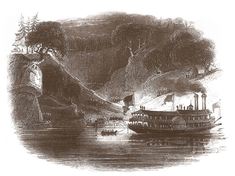 An engraving based on "Gang of Negro Slaves shipping Cotton from a Plantation on the Alabama River, by torchlight--on a Steam Boat for Mobile," painted by William Henry Brooke in 1839. (Alabama Archives)
An engraving based on "Gang of Negro Slaves shipping Cotton from a Plantation on the Alabama River, by torchlight--on a Steam Boat for Mobile," painted by William Henry Brooke in 1839. (Alabama Archives) The Alabama Territory’s cultural and economic landscape was well defined by spring 1818. As the territory entered its second year of existence, cotton, transportation networks to facilitate its trade, and a fundamental reliance on slave labor had meshed to form the key parts of the structural bedrock on which the new state would rise. During the year ahead, these aspects of the territorial experience would both cement and extend their influence into virtually every aspect of Alabama life. One particularly significant area was transportation. Alabama’s first steamboats were a far cry from the floating palaces of river travel’s heyday—slower, smaller, and far less powerful or reliable than those of the coming generation—but they marked the beginning of the era of revolution in riverine transportation.
 RSS Feed
RSS Feed